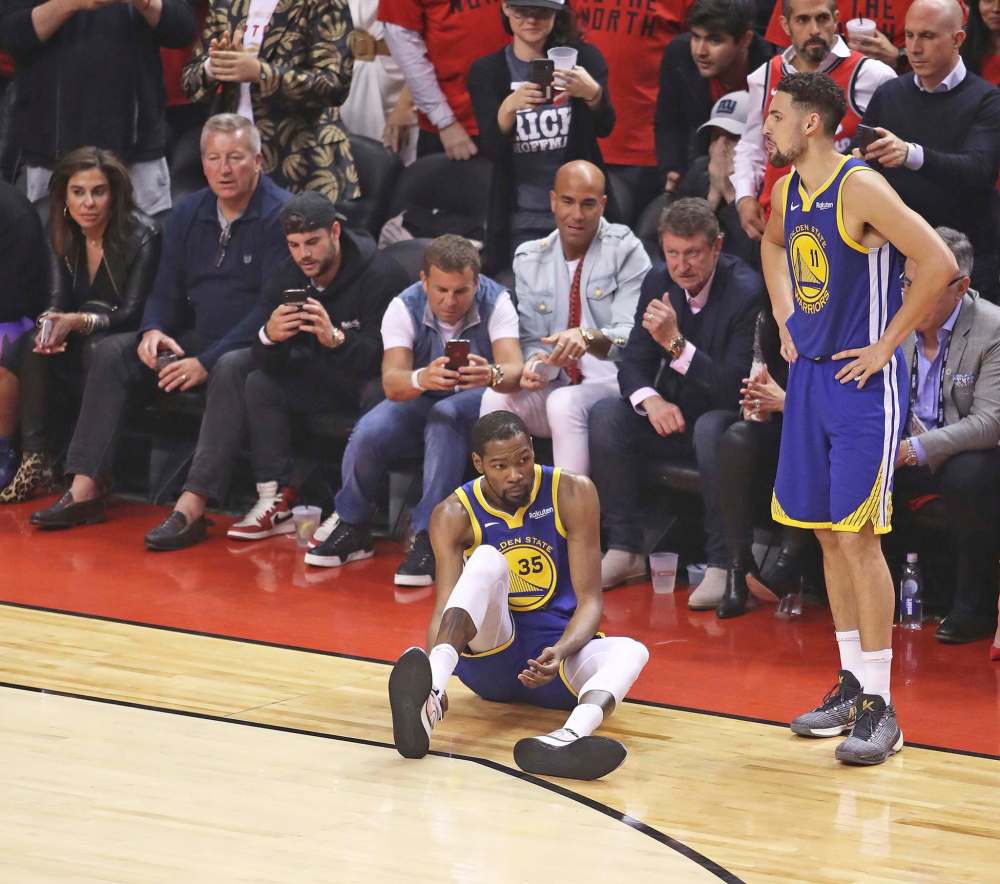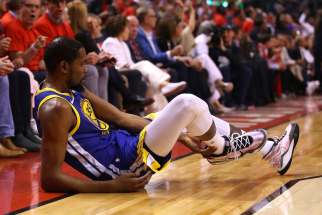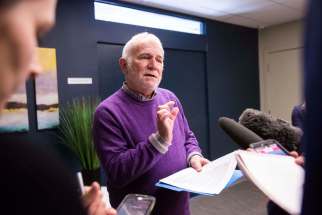Durant pays dearly for desperate Warriors’ high-risk gamble
Read this article for free:
or
Already have an account? Log in here »
To continue reading, please subscribe:
Monthly Digital Subscription
$0 for the first 4 weeks*
- Enjoy unlimited reading on winnipegfreepress.com
- Read the E-Edition, our digital replica newspaper
- Access News Break, our award-winning app
- Play interactive puzzles
*No charge for 4 weeks then price increases to the regular rate of $19.00 plus GST every four weeks. Offer available to new and qualified returning subscribers only. Cancel any time.
Monthly Digital Subscription
$4.75/week*
- Enjoy unlimited reading on winnipegfreepress.com
- Read the E-Edition, our digital replica newspaper
- Access News Break, our award-winning app
- Play interactive puzzles
*Billed as $19 plus GST every four weeks. Cancel any time.
To continue reading, please subscribe:
Add Free Press access to your Brandon Sun subscription for only an additional
$1 for the first 4 weeks*
*Your next subscription payment will increase by $1.00 and you will be charged $16.99 plus GST for four weeks. After four weeks, your payment will increase to $23.99 plus GST every four weeks.
Read unlimited articles for free today:
or
Already have an account? Log in here »
Hey there, time traveller!
This article was published 11/06/2019 (2372 days ago), so information in it may no longer be current.
It’s the pop seen — and felt — across the sporting world. And it could carry ramifications far beyond the NBA Finals.
In case you missed it, Kevin Durant was just over 11 minutes back into writing a pretty impressive comeback story Monday night, knocking down 11 points in his first action since being sidelined in early May with a calf injury. His Golden State Warriors, with their season on the line, had raced out to an early lead against the Toronto Raptors,
And then it all came undone, quite literally in this case. Seeing it live, as I did at Scotiabank Arena, was tough enough. But a graphic video making the rounds on social media shows the exact moment when something clearly snaps in Durant’s leg, like a rubber band that is sent flying. If you’re at all squeamish, I’d suggest you don’t seek this one out.
It all led to a truly sad scene, with Durant writhing in agony, as a loud contingent of Toronto fans initially roared in delight — some imbeciles can be seen actually waving bye-bye to the Warriors superstar — before being shamed into showing some class by a handful of Raptors players and even the public address announcer as he was helped off the court.
The early diagnosis is a ruptured Achilles tendon, which is a pretty devastating injury to an elite superstar like Durant, given the fact he is 30 and a free agent after this season who was set to cash in. Now, both his short- and long-term future are a question mark, never mind the fact Golden State still trails the best-of-seven series 3-2 and will have to win two more games without him if they are to capture a third-straight championship, beginning Thursday night in Oakland.
But this is about a lot more than a basketball game. Durant’s case raises all kinds of moral and ethical questions — not to mention possible legal ones — about allowing a player back into the lineup when they are clearly still not at 100 per cent and exposing them to even greater risk, all in the name of trying to win.
Durant may have just cost himself millions of dollars in future earnings. He may never again be the same. And for what, really?

Every organization has a system of checks and balances in place, including doctors who consult with coaches and management. But as we’ve seen time and time again, especially when it comes to head injuries, those systems are filled with flaws and loopholes and often break down.
Remember when Jets defenceman Dustin Byfuglien was clearly knocked woozy last season after a hard collision with Pittsburgh’s Jamie Oleksiak? His legs turned to rubber as he struggled to get back to the bench, only to return to action minutes later after somehow passing concussion protocol. The whole thing became even more of a joke when Byfuglien was officially diagnosed with a concussion the following day.
All of which underscores the biggest problem of all when it comes to assessing injuries: nearly all athletes out there, especially when the stakes are at their highest, truly believe they can simply suck it up and perform and will tell everyone within shouting range to “put me in, coach, I’m ready to play!”
It’s the way they’re wired, a big part of what has carried them to the highest level. And they’ll be damned if they’re going to let a little pain or discomfort get in their way, or let some guy in a white coat with a fancy degree stop them from suiting up.
Coaches love it. Teammates love it. Fans love it. And the media love it. We often compare these players to modern-day gladiators, raving about their guts and bravery as we talk about them going into battle. Strength and power is celebrated. Weakness and vulnerability is demonized.

Just look at the Stanley Cup playoffs. Zdeno Chara is currently adding his name to hockey lore by playing through what is pretty much a broken face. No, he can’t chew and is barely able to speak, but he’s still putting in 25 minutes a night for his Boston Bruins.
Closer to home, we saw Jets forward Nikolaj Ehlers dress in Game 6 against the St. Louis Blues despite having a broken bone in his leg. It was a puzzling decision in hindsight, given the flashy winger’s biggest weapon is his skating and he was rendered pretty much invisible in what turned out to be Winnipeg’s final game of the year.
But again, that’s the way it goes. Ehlers, basically on one good leg, was deemed a better option than the next guy up, likely with the belief that everyone would rally around his Herculean effort.
Following Golden State’s dramatic, come-from-behind 106-105 victory Monday night, the final result became secondary to the surreal scene playing out at the podium.
Bob Myers, the team’s president of basketball operations, was reduced to tears as he fielded questions about seemingly rushing Durant back into action in a “must-win” situation and immediately giving him big minutes when he wasn’t deemed healthy enough to put on a jersey a few days earlier — only to have it all backfire in a major way.
“He was cleared to play; that was a collaborative decision. I don’t believe there’s anybody to blame, but I understand in this world and if you have to, you can blame me. I run our basketball operations department. And to tell you something about Kevin Durant, Kevin Durant loves to play basketball, and the people that questioned whether he wanted to get back to this team were wrong,” said an emotional Myers, clearly trying to get in front of the wave of criticism he knows is coming team executives’ way.
For added context, Durant has often been labelled as a selfish, me-first type player with previous questions raised by media, fans and even other players about whether his initial injury was as serious as the team claimed, or whether he was just being a big baby and milking it, essentially.
“He’s one of the most misunderstood people. He’s a good teammate, he’s a good person, it’s not fair. I’m lucky to know him. I don’t know — I don’t have all the information on what really the extent of what it all means until we get a MRI, but the people that worked with him and cleared him are good people, they’re good people,” said Myers.
‘Because he’s a warrior. You saw what he did (Monday night), he sacrificed his health for us and we dearly miss him. It was very deflating to see him go out’–Klay Thompson
Durant’s distraught teammates were blunt about the situation, saying he had nothing to prove to critics.
“F— them,” DeMarcus Cousins said when asked for his response to those who might question Durant’s heart.
Klay Thompson expanded on that sentiment.
“Without him we’re a really good team, but it’s you throw Kevin Durant out there, like I said before, one of the greatest ever. So we don’t pay that any attention because that’s just stupid. Stupid,” Thompson said.
“Because he’s a warrior. You saw what he did (Monday night), he sacrificed his health for us and we dearly miss him. It was very deflating to see him go out.”

And there it is, talk of being a “warrior” and “sacrificing” his health. Which is why, despite the very painful lesson everyone could learn from the Durant situation, I wouldn’t hold my breath expecting anything to change.
Athletes will continue to put their bodies on the line with reckless disregard for anything else but chasing the next win, and the culture of complicity that exists within sports organizations will likely continue to stand by and keep allowing it to happen.
No pain, no gain? Perhaps it’s time to rethink that archaic logic.
mike.mcintyre@freepress.mb.ca
Twitter: @mikemcintyrewpg

Mike McIntyre grew up wanting to be a professional wrestler. But when that dream fizzled, he put all his brawn into becoming a professional writer.
Our newsroom depends on a growing audience of readers to power our journalism. If you are not a paid reader, please consider becoming a subscriber.
Our newsroom depends on its audience of readers to power our journalism. Thank you for your support.










